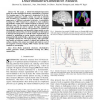Free Online Productivity Tools
i2Speak
i2Symbol
i2OCR
iTex2Img
iWeb2Print
iWeb2Shot
i2Type
iPdf2Split
iPdf2Merge
i2Bopomofo
i2Arabic
i2Style
i2Image
i2PDF
iLatex2Rtf
Sci2ools
109
Voted
TMI
2008
2008
Brain Anatomical Structure Segmentation by Hybrid Discriminative/Generative Models
In this paper, a hybrid discriminative/generative model for brain anatomical structure segmentation is proposed. The learning aspect of the approach is emphasized. In the discriminative appearance models, various cues such as intensity and curvatures are combined to locally capture the complex appearances of different anatomical structures. A probabilistic boosting tree (PBT) framework is adopted to learn multiclass discriminative models that combine hundreds of features across different scales. On the generative model side, both global and local shape models are used to capture the shape information about each anatomical structure. The parameters to combine the discriminative appearance and generative shape models are also automatically learned. Thus, low-level and high-level information is learned and integrated in a hybrid model. Segmentations are obtained by minimizing an energy function associated with the proposed hybrid model. Finally, a grid-face structure is designed to explic...
Related Content
| Added | 15 Dec 2010 |
| Updated | 15 Dec 2010 |
| Type | Journal |
| Year | 2008 |
| Where | TMI |
| Authors | Zhuowen Tu, Katherine Narr, Piotr Dollár, Ivo D. Dinov, Paul M. Thompson, Arthur W. Toga |
Comments (0)

